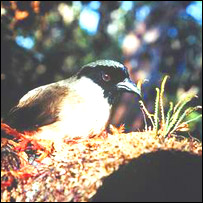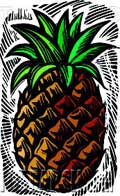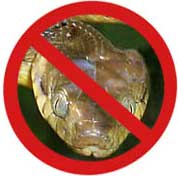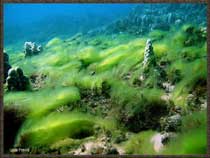| (insert your NIE or newspaper logo here) |
Weekly Online LessonOnline Lesson ArchiveGrade Level: 7-10
|
Hawaiian Natives Disappear
 Scientists
announced on November 30, 2004, that the po'ouli -- a native Hawaiian
honeycreeper -- will soon be just a memory kept alive by photos, data,
and stuffed specimens.
Scientists
announced on November 30, 2004, that the po'ouli -- a native Hawaiian
honeycreeper -- will soon be just a memory kept alive by photos, data,
and stuffed specimens.
One of the three po'ouli birds known to still exist died in captivity due to avian malaria, spread by mosquitoes -- a species not native to Hawaii. Since then, scientists have been urgently searching for the remaining male and female, but neither has been spotted for over a year.
Out of the 200-plus native bird species originally recorded in Hawaii, a few dozen are either threatened or endangered, while another few dozen have gone extinct. Meanwhile, nearly 50 exotic bird species have been introduced and continue to spread among the island habitats.
But it's not only the birds that are getting squeezed out of paradise. Native mammals, plants and invertebrates are also struggling to survive on their home turf.
Habitat destruction and problems caused by non-native species have been happening for decades in Hawaii. Some introduced species, including pineapple, were brought by early Polynesians who migrated to these islands. Beginning in the mid-1850s, large-scale growers cleared more land, applied pesticides, and developed irrigation systems to improve crop production.
Today, Hawaii's populations of human and non-native species continue to grow. So in this week's lesson, you'll explore parts of the Hawaiian Islands to get a first-hand look at the exotic invasion and see what challenges the natives face in reclaiming their territory.
Native Or Not?
 Let's
begin by getting a taste of Hawaii at the Conservation
Hawaii site, I'm
Mr. Native (Not!).
Let's
begin by getting a taste of Hawaii at the Conservation
Hawaii site, I'm
Mr. Native (Not!).
Read the introduction -- what's the difference between an endemic species and an indigenous one?
Click the dancing hula girl to read about eating native...not! Are you surprised by any of the non-native menu items?
Next, review a few of the non-native Birds, Flowers, and Pests.
Now let's hop over to another site at Conservation Hawaii to explore the Silent Invasion and browse through the Top 10 Most Wanted.
How exactly did these exotic species get to the islands? What problems do they cause for native species?
 So,
Why
Is Hawaii So Vulnerable to these invasions? Make sure to
dig a little deeper into the Invasion:
A Story Of Damage and why there are Gaps
In The System.
So,
Why
Is Hawaii So Vulnerable to these invasions? Make sure to
dig a little deeper into the Invasion:
A Story Of Damage and why there are Gaps
In The System.
Review some suggestions about What We Can Do. In what ways would the 10 Point Action Plan help stop the spread of exotics? What steps must be taken to implement these suggested changes?
If you you're interested, you can also scope out more of Hawaii's native Forest Birds, Invasive Marine Algae, and Introduced Marine Species.
Time To Investigate
Now that you've studied the basics of the invasion and gotten familiar with some of the local natives, you're ready to take the Navigating Change Challenge and explore the Northwestern Hawaiian Islands.
You'll need Flash Player, and speakers turned on if you want (and can have) some music while you work through your missions.
 Click
the button that reads, Click here to start. You'll
be prompted to register -- go ahead and register then login, as this
is used to track your progress during the mission.
Click
the button that reads, Click here to start. You'll
be prompted to register -- go ahead and register then login, as this
is used to track your progress during the mission.
Once launched, you'll be briefed about your mission. Then you'll need to deal with all of the Voyage Prep details, which includes meeting your crew members and choosing a team of experts.
Launch the voyage and get moving on Mission 1. Explore the area and when you uncover a clue, read it (sometimes there's a Next Page), then click Save Clue and Continue. You can View Inventory on the right hand side (click blue tab) to see how many clues are left to find.
After you complete Mission 1, continue through Mission 2 and Mission 3.
What changes in the native environment have been the most challenging for the native wildlife? What clues influenced your decision the most about which course of action to take? If one or two of those clues had been missing, but you had to choose an action anyway, what might you have chosen instead? What would have been the predicted result?
Newspaper Activities
Browse current issues of Targetnewspaper for articles about Hawaii's native habitats and wildlife, or about endangered species elsewhere. What exactly are the threats to native populations? How did these circumstances come about? Do different groups of people agree or disagree over what should be done? What do scientists have to say about it? What is being done to protect habitat or species in an area that's threatened? Has anyone suggested additional improvements for better protection? If so, would they work? What must be invested? How might it affect government agencies or trade and transportation industries?
© Copyright 2004
Learners
Online,
Inc.
